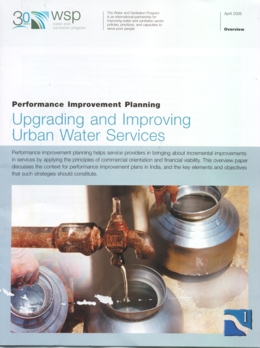|
 The water supply and sanitation sector in India continues to be plagued with severe deficiencies in the availability, quality, and equity of services. Though access to infrastructure may be increasing in some cases, access to reliable, sustainable, and affordable water supply and sanitation services remains poor in general. Services remain deficient, with water available for only few hours a day; many remain unconnected to the network, and wastewater is disposed of without adequate treatment. Consumers often spend large sums of money on expensive and unsafe alternatives to cope with poor services. Contents: Executive Summary Context How Do We Bring about Better Services Performance Improvement Plans Principles of Performance Improvement Plans Institutionalizing for Long-Term Results through Performance-Level Monitoring Workforce Development and Training Consultation and Communication with the Communities Conclusions
Post Date : 01 April 2009 |